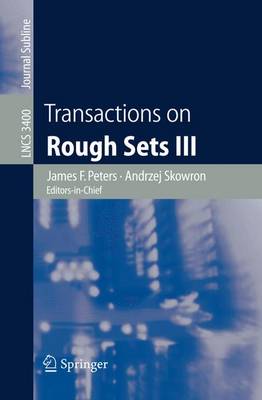Lecture Notes in Computer Science
2 primary works
Book 3400
Volume III of the Transactions on Rough Sets (TRS) introduces advances in the theory and application of rough sets. These advances have far-reaching impli- tions in a number of researchareas such as approximate reasoning, bioinform- ics,computerscience,datamining,engineering(especially,computerengineering and signal analysis), intelligent systems, knowledge discovery, pattern recog- tion,machineintelligence,andvariousformsoflearning. This volumerevealsthe vigor, breadth and depth in research either directly or indirectly related to the rough sets theory introduced by Prof. Zdzis law Pawlak more than three decades ago. Evidence of this can be found in the seminal paper on data mining by Prof. Pawlak included in this volume. In addition, there are eight papers on the theory and application of rough sets as well as a presentation of a new version of the Rough Set Exploration System (RSES) tool set and an introduction to the Rough Set Database System (RSDS). Prof. Pawlak has contributed a pioneering paper on data mining to this v- ume. In this paper, it is shown that information ?ow in a ?ow graph is governed by Bayes' rule with a deterministic rather than a probabilistic interpretation.
A cardinal feature of this paper is that it is self-contained inasmuch as it not only introduces a new viewof information?owbut alsoprovidesanintroduction to the basic concepts of ?ow graphs. The representation of information ?ow - troduced in this paper makes it possible to study di?erent relationships in data and establishes a basis for a new mathematical tool for data mining. Inadditionto thepaperbyProf.
A cardinal feature of this paper is that it is self-contained inasmuch as it not only introduces a new viewof information?owbut alsoprovidesanintroduction to the basic concepts of ?ow graphs. The representation of information ?ow - troduced in this paper makes it possible to study di?erent relationships in data and establishes a basis for a new mathematical tool for data mining. Inadditionto thepaperbyProf.
Book 3700
Volume IV of the Transactions on Rough Sets (TRS) introduces a number of new advances in the theory and application of rough sets. Rough sets and - proximationspaceswereintroducedmorethan30yearsagobyZdzis lawPawlak. These advances have profound implications in a number of research areas such as the foundations of rough sets, approximate reasoning, arti?cial intelligence, bioinformatics,computationalintelligence, cognitivescience, intelligentsystems, datamining,machineintelligence,andsecurity. Inaddition,itisevidentfromthe papers included in this volume that the foundations and applications of rough sets is a very active research area worldwide. A total of 16 researchers from 7 countries are represented in this volume, namely, Canada, India, Norway, S- den, Poland, Russia and the United States of America. Evidence of the vigor, breadth and depth of research in the theory and applications of rough sets can be found in the 10 articles in this volume. Prof. Pawlak has contributed a treatise on the philosophical underpinnings of rough sets. In this treatise, observations are made about the Cantor notion of a set, antinomies arising from Cantor sets, the problem of vagueness (es- cially, vague (imprecise) concepts), fuzzy sets, rough sets, fuzzy vs. rough sets as well as logic and rough sets. Among the many vistas and research directions suggested by Prof. Pawlak, one of the most fruitful concerns the model for a rough membership function, which was incarnated in many di?erent forms since its introduction by Pawlakand Skowronin 1994. Recall, here, that Prof.

